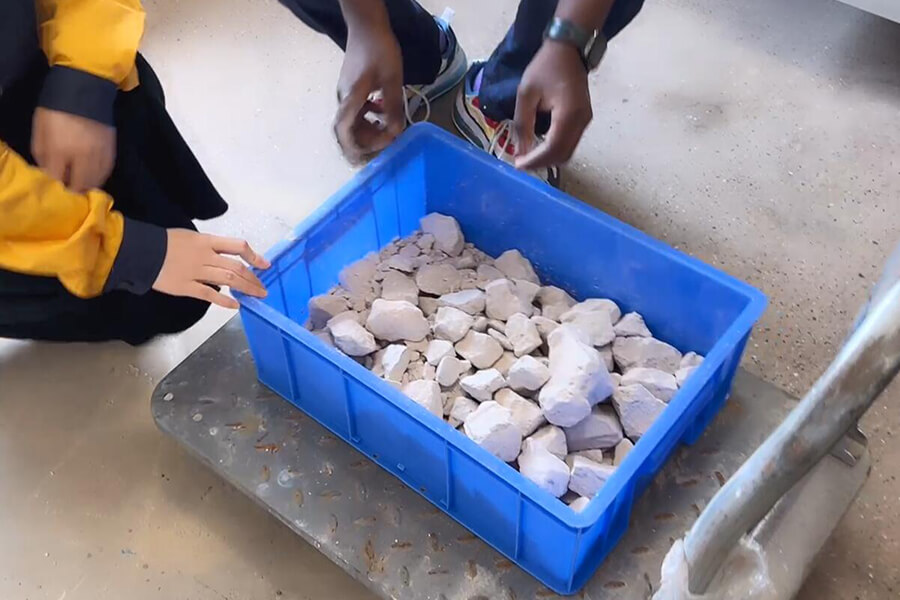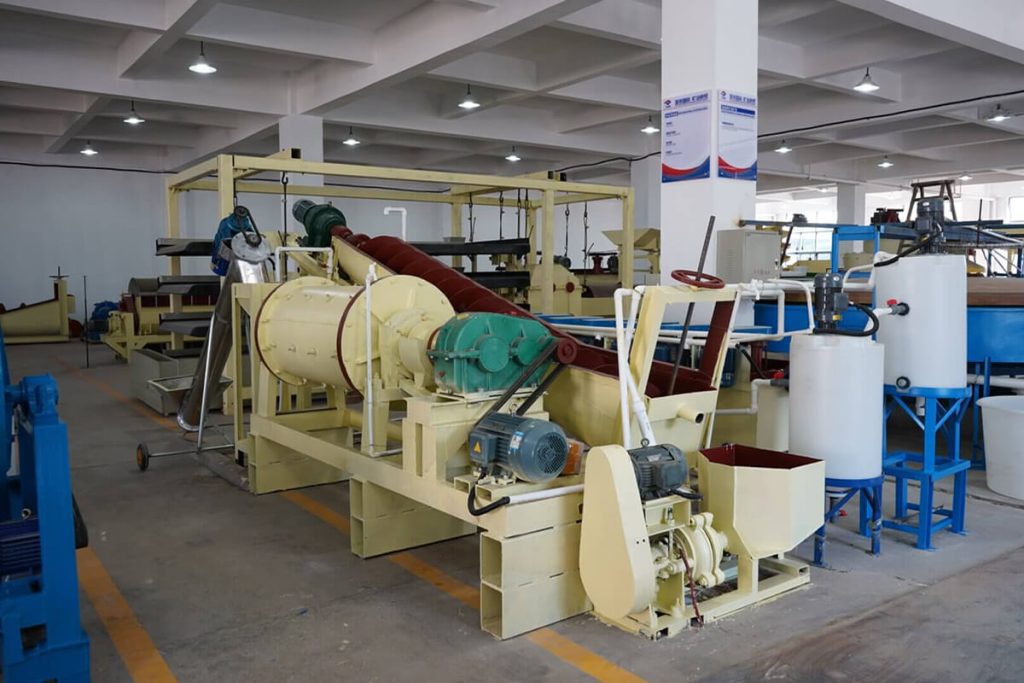Kaolin is a non-metallic mineral resource with good adsorption, plasticity, and stability. It has wide applications in paper, ceramics, rubber, and refractory materials. Most kaolin beneficiation processing adopts wet processing, which includes several stages like slurry dispersion, grading, impurity separation, and product treatment. The general process is: raw ore → crushing → slurry compaction → sand removal → cyclone classification → kaolin processing technology and process flow. In recent years, with the increasing demand for kaolin, research on kaolin-modifying agentia and processes has become increasingly mature.

The purpose of purifying kaolin is to remove harmful dyeing impurities such as iron minerals, titanium minerals, and organic substances, to improve the whiteness of the product, or to remove sandy minerals such as quartz and feldspar, to improve the quality of kaolin products, expand its application width and depth, obtain better economic benefits, and fully utilize kaolin resources. The purification processes mainly include gravity separation, magnetic separation, flotation, leaching, chemical bleaching, and roasting. Gravity separation is to remove impurities such as organic substances, feldspar, and quartz; Magnetic separation is to remove weak magnetic impurities such as hematite, pyrite, and limonite; Flotation is often used to treat kaolin raw ore with high impurities and low whiteness; Leaching is for iron reduction and purification of low-grade kaolin; Chemical bleaching is for further purifying kaolin concentrates and obtain high-quality kaolin; Calcination is to remove carbon from coal-based kaolin, and metal impurities can also be removed through processes such as magnetization roasting and chlorination roasting.
Kaolin Washing Experimental Steps
The raw material of kaolin clay size is 0-10mm.Flowing are the steps for testing.
- Washing. The spiral sand washing machine washes the kaolin clay.
- Separation. The material from the spiral washing machine goes to hydrocyclone to separate the mud and water.
- Magnetic Separation. Then the material from the hydro cyclone goes to the magnetic separator and selects magnetic minerals from the slurry.
- Grinding. Put the silicon sand in the kaolin into a ball mill for grinding.
- Flotation. Put the material from the ball mill into a flotation machine to remove mica.
- High gradient magnetic separation. After classification and desliming, pour the material into a high-gradient magnetic separator for separation and purification.
- Spiral sand washing machine (kaolin)
Purpose: clean raw ore materials.
Experimental process: Put kaolin into the spiral sand washing machine, which arranges at a 15 ° angle. The lower part of the water tank consists of a three-sided weir plate to form a sedimentation tank. The spiral head gently down to the sedimentation tank. The spiral drive is by an electric motor with a reducer to rotate continuously. The cleaning water flows through the porous plate at the bottom of the sedimentation tank. By adopting the principle that solid particles of different sizes and densities have different settling velocities in liquids, fine ore flows out from the overflow, and coarse ore settles at the bottom of the tank. Pushing the screw upwards and discharging, grading the coarse material, rotated into the feed port of the ball mill by using a spiral blade of the spiral washer, and the filtered fine Kaolin discharge from the overflow pipe. This equipment has three functions: cleaning, dehydration, and grading.
- Hydrocyclone (kaolin)
Purpose: To classify materials.
Experimental process: The cleaned material enters the hydrocyclone, and the mixture is separated at high speed by centrifugal force through the particle size difference between coarse and fine particles. Most of the coarse particles discharge through the bottom flow port of the cyclone, and most of the fine particles discharge through the overflow pipe, achieving the purpose of separation and classification.
- Wet magnetic separator (kaolin)
Purpose: Separate the magnetic materials from graded kaolin clay.
Experimental process: put the graded fine material into a wet magnetic separator to separate the magnetic substances in the kaolin powder material. The equipment has a large magnetic field gradient and can work with various special magnetic conductive stainless steel media to meet the beneficiation needs of different types of minerals
- Ball mill (silica sand in kaolin)
Purpose: Grind silica sand to 0.7mm
Experimental process: Pour the material into a ball mill, and through the collision between the steel ball and the material, grind the material into powder of 0-0.7mm or 0-200mesh as needed.

- Classifier (silica sand in kaolin)
Purpose: To classify the particle size of the material and form a closed circuit grinding process with the ball mill. The coarse particles return to the ball mill for further grinding, while the fine particles enter the following equipment.
Experimental process: Through the height difference, the discharge of the ball mill flows automatically to the classifier, and reaches the required particle size.
- Laboratory flotation machine (silica sand in kaolin)
Purpose: To remove mica from silica sand
The functions of the laboratory flotation machine: it is a mineral separating equipment that requires additional conventional reagents. Different material requires different chemicals.
Experimental process: Pour the slurry into the tank and dilute it with water to the required concentration; Start the motor and add an appropriate amount of flotation drugs according to the experimental requirements; When the foam is generating in the tank, turn on the switch of the scraper part to start flotation; After reaching the specified flotation time, turn off the motor to stop the impeller and scraper from running;
- High gradient magnetic separator for silica sand in kaolin
Purpose: To remove iron from silica sand
The high gradient magnetic separator is a magnetic separator for separating weakly magnetic minerals. For example, it can remove iron in silica sand.
Experimental process: Pour the material into a high-gradient magnetic separator, which generates an induced magnetic field in the sorting area and a high-gradient magnetic field on the surface of the magnetic medium located in the sorting area; The rotating ring rotates clockwise to continuously feed and transport the magnetic medium out of the sorting area; The slurry is fed into the ore hopper and flows through the rotating ring along the gap of the upper iron yoke. The magnetic particles in the slurry are adsorbed on the surface of the magnetic medium rod, transported by a rotating ring to the top non-magnetic field area, and washed into the concentrate hopper by flushing water. Non-magnetic particles pass through the magnetic medium pile under gravity and pulsating fluid force and separate from the magnetic particles. Then it flows into the tailings hopper along the gap of the lower iron yoke for discharge.
Kaolin has wide applications in various industries like papermaking, ceramics, and refractory materials. The excellent properties of modified kaolin and nanometre kaolin have enabled kaolin to gain more extensive research and application prospects, and it remains a hot research direction for future kaolin application research. At the same time, this also has stricter requirements for the quality of kaolin. Asia Africa International laboratory test service provides accurate and reliable test results to meet the different needs of customers. Our advanced equipment, experienced engineers, and technical personnel help our clients better optimize their mining operations. Welcome to inquire and consult!
